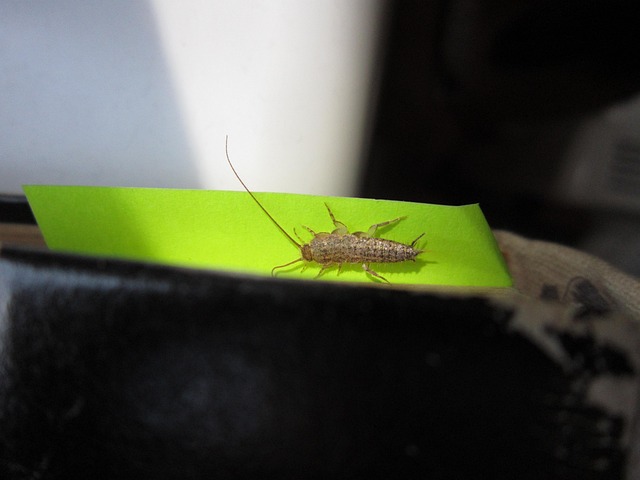Silverfish infestations require prompt action due to their nocturnal habits and preference for damp organic environments. Professional silverfish control services offer effective, tailored solutions using eco-friendly baits, gel traps, and advanced residential/commercial treatments. Early detection through inspecting dark areas for small insects, fabric damage, and shed skin is crucial. These professionals identify entry points, eradicate infestations, and prevent recurrences with methods suited to residential or commercial spaces.
Silverfish are persistent pests that can quickly invade homes and businesses, leaving behind unsightly damage. This comprehensive guide explores effective treatments to eliminate silverfish infestations, focusing on both professional and eco-friendly approaches. We delve into understanding the behavior and habitat of these insects, from their hiding spots to feeding habits, to provide tailored solutions for residential and commercial applications. Discover modern methods used by silverfish control services, natural remedies, and integrated pest management strategies to maintain a silverfish-free environment.
Understanding Silverfish Infestations: Behavior and Habitat
Understanding Silverfish Infestations: Behavior and Habitat
Silverfish are nocturnal, elusive pests that thrive in damp, humid environments. They are attracted to organic materials like paper products, cardboard, and fabrics, making them common inhabitants of residential and commercial spaces alike. These insects are particularly adept at hiding in tight crevices, making it difficult for homeowners and businesses to spot an infestation until it has escalated. Professional silverfish control services often employ a combination of eco-friendly solutions, such as baits and gel traps, to effectively target these hard-to-reach areas without resorting to harsh chemicals.
Residential and commercial properties alike can fall victim to silverfish infestations, which is why prompt action is crucial. If you suspect a silverfish problem, whether in your home or workplace, it’s essential to contact professional silverfish extermination services near you. They possess the expertise and tools, including advanced residential silverfish treatment methods, to eliminate existing populations and prevent future recurrences effectively. Commercial silverfish removal requires specialized techniques due to larger scale and diverse habitats, but eco-friendly solutions can be tailored to minimize disruptions while maximizing results.
– Identifying silverfish signs and symptoms
Recognizing the signs of a silverfish infestation is the first step towards effective control. These tiny insects leave distinct traces of their presence, often indicating a growing problem. Keep an eye out for small, shiny, wingless creatures scurrying in dark corners, particularly in kitchens and bathrooms. Silverfish are attracted to moisture and food sources like starchy items and paper products. You might also notice damage to fabrics, such as stained or torn clothing, and webbing in affected areas. Look for shed skin casings, which can resemble small, white, rice-like particles, providing evidence of their activity.
If you suspect a silverfish infestation, it’s crucial to act swiftly. Professional silverfish extermination services offer specialized treatments tailored to the extent of the problem. From residential silverfish control to commercial removal, these experts utilize advanced methods and eco-friendly solutions to ensure effective and long-lasting results. With their knowledge and tools, they can identify hidden entry points and eradicate every last silverfish, preventing future infestations. For those seeking immediate relief, professional services are readily available, offering peace of mind and a pest-free environment.
– Common areas where silverfish hide and breed
Silverfish are elusive pests that tend to prefer dark, moist environments, making them hard to spot until an infestation becomes severe. Common hiding spots and breeding grounds include cracks and crevices in walls, behind appliances, under sinks, in basements or attics, and within carpeted areas. They are particularly drawn to organic materials like paper products, cardboard boxes, and fabric, which serve as both food sources and shelter. In residential settings, these pests can quickly multiply in homes with poor ventilation, high humidity levels, or areas experiencing water leaks. Commercial spaces, especially those with food processing facilities or storage rooms, also provide ideal conditions for silverfish to thrive and breed.
Professional silverfish extermination services employ a range of effective treatments, from traditional pesticides to eco-friendly solutions. Residential silverfish treatment often involves targeted applications of liquid insecticides in infested areas, while commercial silverfish removal requires more comprehensive strategies due to the larger scale and potential health risks associated with food contamination. Some professional services offer specialized equipment for steam or carbon dioxide treatments, which eliminate pests without harsh chemicals. For those concerned about eco-friendliness, there are natural solutions like diatomaceous earth or neem oil that can be highly effective in silverfish infestation removal while minimizing environmental impact.
– Life cycle and feeding habits of silverfish
Silverfish are elusive pests that thrive in dark, humid environments, making them hard to spot until an infestation takes hold. These insects go through a complete metamorphosis, with four distinct stages: egg, nymph, and adult. During their life cycle, they shed their skin several times, growing larger with each molt. Silverfish feed on a variety of organic materials, including starchy items like paper products, fabrics, and even book bindings. They are particularly attracted to damp environments, often hiding in cracks, crevices, and behind walls, making them difficult to eliminate once established.
Professional silverfish control services employ a range of effective treatments to combat these pests, from traditional chemical pesticides to eco-friendly solutions. Residential silverfish treatment plans may include targeted applications of liquid insecticides or baits designed to attract and kill silverfish. Commercial silverfish removal requires a more comprehensive approach, often involving inspection, sanitation, and the use of specialized equipment to reach hard-to-access areas. For those seeking silverfish infestation removal without harsh chemicals, there are eco-friendly silverfish solutions available, such as using natural repellents like neem oil or diatomaceous earth.
In light of the above information, it’s clear that effective silverfish control requires a comprehensive understanding of their behavior and habitat. For persistent infestations, professional silverfish extermination services offering eco-friendly solutions are ideal for both residential and commercial spaces. With tailored treatments and expert knowledge, these services ensure swift and lasting silverfish infestation removal, giving you a pest-free environment. Don’t delay; reach out to local silverfish pest control experts today to reclaim your space.
